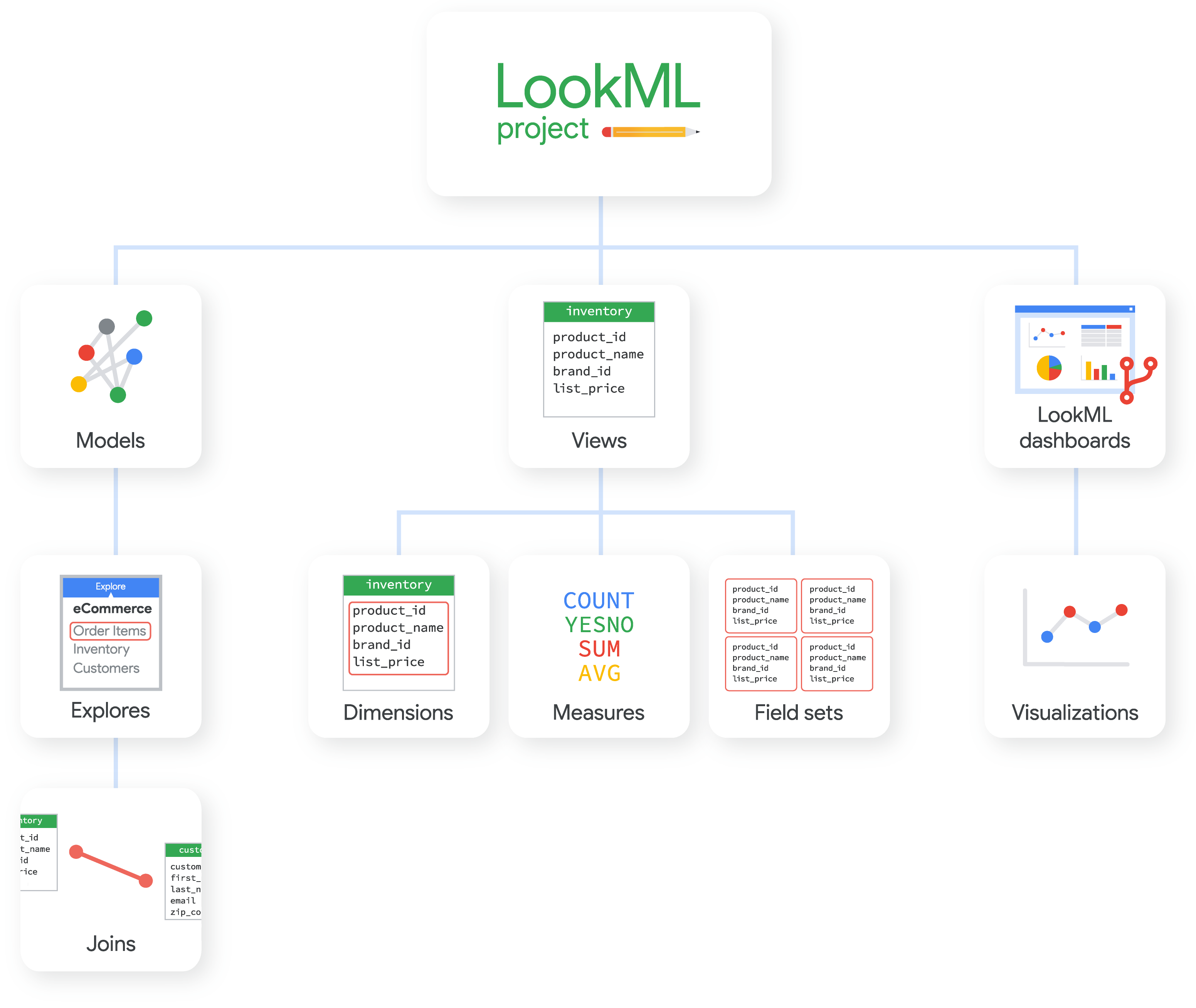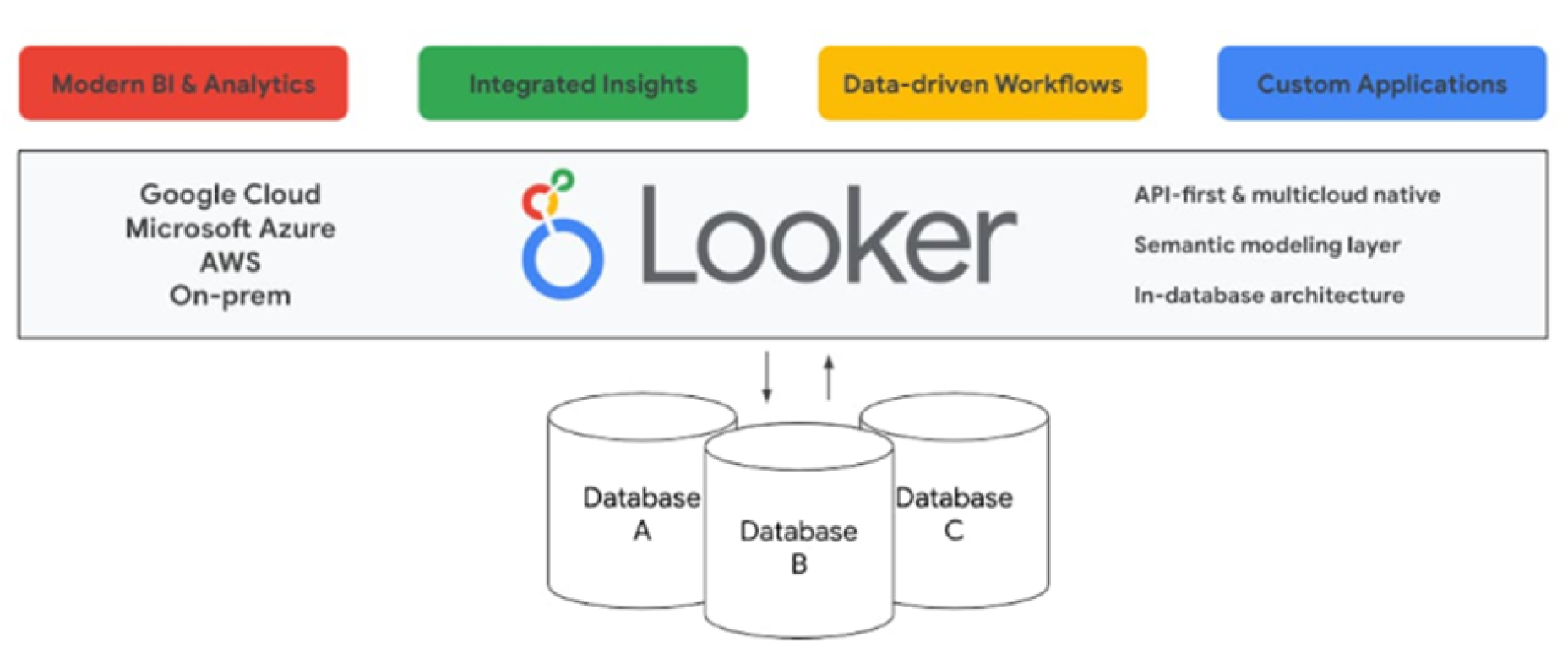1. Introduction of looker :
Data is one of the most valuable assets for any business, but making sense of it can be challenging without the right tools. Looker is a modern business intelligence platform designed to help companies turn complex data into clear insights. By connecting directly to data sources, Looker enables teams to explore, visualize, and share information effortlessly. Whether it’s tracking sales performance, understanding customer behaviour, or improving operational efficiency, Looker makes it easy for everyone in an organization to access meaningful insights without requiring technical expertise.
What sets Looker apart is its ability to transform raw data into actionable knowledge. With customizable dashboards, real-time reporting, and seamless collaboration features, Looker ensures everyone—from executives to frontline staff—has the right information at the right time. It’s more than just presenting data; it’s about empowering businesses to make confident, informed decisions that drive growth, efficiency, and innovation.
How Looker Works
Looker’s architecture and workflow are designed to simplify data exploration while maintaining flexibility and scalability. At its core, Looker relies on a robust modelling layer to bridge the gap between raw data and insightful visualizations.
Here’s a clear breakdown of its key components:
LookML One of the foundational elements of Looker is LookML, its proprietary modelling language used to define how data is structured, connected, and displayed. It acts as a bridge between raw database data and the visual reports seen in Looker. With LookML, data teams can:
- Set consistent rules for data calculations, filtering, and presentation.
- Simplify complex database queries, enabling business users to explore data without writing code.
- Ensure reliable and repeatable insights across all dashboards and reports.
In essence, LookML transforms raw data into clear, reliable insights accessible across an organization. This foundational layer sets the stage for Looker’s core components, enabling seamless interaction with data at every stage of analysis.
- Models: These define how data from various sources is organized and connected. Models act as the foundation for all data exploration and analysis.
- Views: A view specifies a list of fields (dimensions or measures) and maps them to an underlying table or derived table. Views can also join other views, creating relationships defined in the model file.
- Explores: Explores are interactive environments where users can query, filter, and analyse modelled data without requiring SQL or programming knowledge.
- Dashboards: Insights derived from Explores are visualized and organized in dashboards. These dashboards present critical metrics in an easy-to-digest format and can be tailored to meet team-specific needs.
Together, these components enable Looker to transform raw data into actionable insights. Its intuitive interface and robust modelling capabilities empower organizations to make informed, data-driven decisions confidently in today’s competitive landscape.
2. Key features:
Cloud-Powered Platform: As a fully cloud-based platform, Looker offers great flexibility since there’s no need to download any desktop software to access it. Its cloud-native design makes deployment simple, and it streamlines the implementation of processes and policies, such as permissions and security, ensuring they are easier and safer to manage.
Accelerate Data Application Development: Looker allows developers to craft customized data experiences by connecting components and modules with services to build sophisticated, reusable data products. With the Extension Framework, you can speed up the development of data applications, helping product teams quickly deliver innovative data experiences and address important data challenges.
Optimizing Workflow Automation: Looker’s advanced workflow system enables users to create and schedule reports with customizable delivery conditions. This proactive approach ensures alerts for issues like declining sales or ETL failures, helping businesses stay ahead of potential problems. Scheduled reports keep users informed about business performance in real-time. Additionally, Looker integrates seamlessly with your app ecosystem, automating workflows and enabling quick action based on up-to-date data. With integrations to tools like Slack and Twilio, Looker simplifies data sharing and enhances collaboration.
Seamless Database Integration: Looker connects directly to your database without requiring data extracts or software downloads, allowing you to query databases of virtually any size. It supports a wide range of data sources, including BigQuery, SQL Server, Azure, AWS, and more. Additionally, it is compatible with various SQL dialects, such as T-SQL and BigQuery SQL, making it flexible for different environments.
Streamlined Data Access with In-Database Architecture: Looker’s In-database Architecture eliminates the need for an ETL process by connecting directly to your raw data sources. This means there’s no need for data transformations or aggregations before the data is sent to Looker. As a result, the platform is highly efficient and fast, regardless of the size of the data.
Data Governance with Semantic Modelling: Looker utilizes a Semantic Layer Architecture that allows businesses to define consistent business logic across the organization. This helps establish a governance framework, ensuring standardization across all data. It also supports robust data security by enabling row-level and column-level security settings to control user access.
3. Benefits of looker :
Real-Time Data Exploration
- Benefit: Looker provides real-time access to data from various sources, allowing users to see the latest updates immediately. This is crucial for organizations that need to make decisions quickly based on the most current data available.
- Importance: Real-time data exploration ensures that decision-makers always have the most relevant information at their fingertips, which is critical for agility in business environments.
Centralized Data Management
- Benefit: Looker acts as a single platform where data from multiple sources can be integrated and managed. This makes it easier for organizations to maintain consistency and accuracy across different datasets.
- Importance: Centralization helps to eliminate data silos and ensures that all teams are working from the same dataset, reducing errors and inconsistencies in reporting.
Real-Time Data Exploration
- Benefit: Looker provides real-time access to data from various sources, allowing users to see the latest updates immediately. This is crucial for organizations that need to make decisions quickly based on the most current data available.
- Importance: Real-time data exploration ensures that decision-makers always have the most relevant information at their fingertips, which is critical for agility in business environments.
Self-Service Analytics
- Benefit: Looker empowers users to perform their own data analysis without needing to rely on IT or data science teams. Users can create custom queries, build dashboards, and explore data on their own.
- Importance: This self-service capability speeds up the process of getting insights and reduces the workload on technical teams, allowing business users to be more agile and responsive to changes in data.
4. Integration & Compatibility :
Looker integrations connect various tools and external applications to Looker Studio, a platform for business intelligence and data analytics. These integrations can include a wide range of systems, from marketing automation platforms and customer relationship management (CRM) tools to social media networks.
By linking Looker's analytics platform with other software, businesses can access data from different sources, such as databases, spreadsheets, and cloud-based applications. These integrations enable businesses to import, export, and manage data in real-time, ensuring they have the most current information for analysis.
Types of Integration:
1. Application Integrations
Looker integrates seamlessly with various business applications, allowing data insights to be embedded directly into everyday tools. Examples include:
- Salesforce : Embed Looker reports and dashboards within Salesforce to provide sales teams with actionable insights.
- HubSpot : Combine CRM data with Looker analytics for better customer segmentation and targeting.
- Slack : Send alerts and updates from Looker directly to Slack channels for instant team collaboration.
2. Cloud Service Integrations
Leverage Looker’s compatibility with cloud platforms to boost efficiency and scalability:
- Google Cloud : Take advantage of native integrations for real-time analytics and machine learning applications.
- AWS and Azure : Connect with cloud environments to analyse and visualize data stored in S3, Redshift, or other cloud-native databases.
3. Data Pipeline Integrations
Looker works well with data pipeline tools, enabling seamless ETL (Extract, Transform, Load) workflows:
- Fivetran and Stitch : Automate data movement into your warehouse, ready for Looker to model and analyse.
- dbt (Data Build Tool) : Collaborate on data transformation workflows and integrate Looker’s LookML to maintain consistent metrics.
4. Embedded Analytics
Enable Looker dashboards and visualizations to be embedded directly into internal portals, customer-facing applications, or partner platforms. This is ideal for:
- SaaS companies looking to offer built-in analytics to customers.
- Enterprises creating internal tools with integrated insights.
Compatible Databases: Flexible Data Connectivity:
One of Looker’s key strengths lies in its ability to connect with a diverse array of databases, making it a highly versatile choice for businesses with existing data infrastructures. Whether you’re using modern cloud-based solutions or traditional on-premises systems, Looker has you covered.
Supported Databases
Looker connects seamlessly with SQL-compliant databases, including:
- Google Big Query : Leverage the scalability and speed of this fully managed, serverless data warehouse.
- Snowflake : A cloud-native data platform known for its performance, scalability, and multi-cloud compatibility.
- Amazon Redshift : Process petabyte-scale datasets efficiently with this cloud data warehouse.
- MySQL and PostgreSQL : Widely used relational databases perfect for small to medium-sized businesses.
- Microsoft SQL Server : A trusted solution for enterprise data management.
- Oracle Database : Ideal for large-scale legacy systems and enterprise-grade applications.
APIs for Custom Application Development:
Beyond its powerful dashboards and analytics, Looker offers robust APIs that enable businesses to customize their data experiences and workflows. These APIs allow for seamless integration of Looker’s insights into unique business environments.
Key Use Cases for APIs
- 1. Embedding Analytics : Embed Looker dashboards, charts, and visualizations directly into websites or internal applications, enabling users to interact with data without leaving their workflows.
- 2. Automating Workflows : Use APIs to schedule and automate tasks such as report generation, data extractions, or notifications for specific metrics.
- 3. Custom Integrations : Connect Looker with third-party platforms like Salesforce, Slack, or proprietary systems to streamline data-driven decision-making.
5. Use Cases of Looker:
1. Transforming Healthcare Operations and Patient Outcomes Using Looker:
The healthcare industry is increasingly turning to data to enhance patient care and make operations more efficient. Looker, a powerful tool for data analysis, helps healthcare providers gain valuable insights from their data. Let's explore how Looker is making a difference by improving patient care and optimizing operations.
- Reducing Hospital Readmissions : Readmissions to the hospital are costly and may point to problems in patient care. With Looker, healthcare providers can examine patient data to find patterns and risks linked to readmissions. Dashboards in Looker make it easy to spot these factors, allowing healthcare teams to act, like creating personalized follow-up plans, which can lower readmission rates and improve patient care.
- Improving Resource Allocation : Managing resources efficiently is key to handling the high demand in emergency departments. Looker helps healthcare managers track patient flow and resource use in real-time. This information helps them make better decisions about staff schedules and ensure that important resources are available when needed, leading to shorter wait times and better patient care.
2. Boosting Retail Success with Data-Driven Insights:
The retail industry is fast-paced and highly competitive, requiring businesses to understand customer preferences, manage inventory effectively, and drive consistent sales growth. Looker empowers retailers with actionable insights, enabling smarter decisions that enhance customer experiences and increase revenue.
- Targeted Marketing Campaigns : An e-commerce retailer used Looker to study customer buying habits and group their audience into distinct segments. With these insights, they crafted personalized marketing campaigns tailored to each segment’s preferences, resulting in higher conversion rates and stronger customer loyalty.
- Smarter Inventory Management : A physical retail chain leveraged Looker to monitor inventory levels across multiple locations in real-time. This helped them maintain optimal stock levels, prevent overstocking and shortages, and ensure popular products remained available. The result was improved customer satisfaction and a boost in sales.
3. Improving Risk Management and Compliance in Finance with Looker:
In the finance industry, accuracy and compliance are essential for maintaining trust and stability. Looker helps financial institutions analyze complex data, manage risks effectively, and meet regulatory requirements with confidence.
- Fraud Prevention : A major bank used Looker to build advanced fraud detection systems. By analyzing transaction data and spotting unusual patterns, they were able to quickly flag suspicious activities in real time. This proactive approach helped safeguard both the bank and its customers from potential financial fraud.
- Simplifying Regulatory Reporting : A financial services firm leveraged Looker to automate their regulatory reporting processes. This reduced the time and effort spent on gathering and preparing data for compliance audits. The streamlined process not only ensured accurate reporting but also allowed teams to focus on more strategic tasks.
Conclusion:
Looker’s ability to connect seamlessly with various data sources and provide real-time insights empowers businesses to make data-driven decisions with ease. By offering customizable dashboards and self-service analytics, Looker ensures that organizations can explore and visualize data without requiring technical expertise. With its robust architecture and flexible integrations, Looker sets a new standard for business intelligence, enabling companies to turn complex data into actionable insights while maintaining efficiency and collaboration.
 Loading Please Wait...
Loading Please Wait... Loading Please Wait...
Loading Please Wait...

